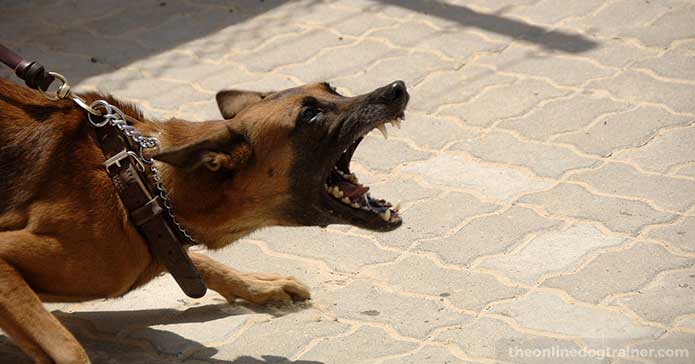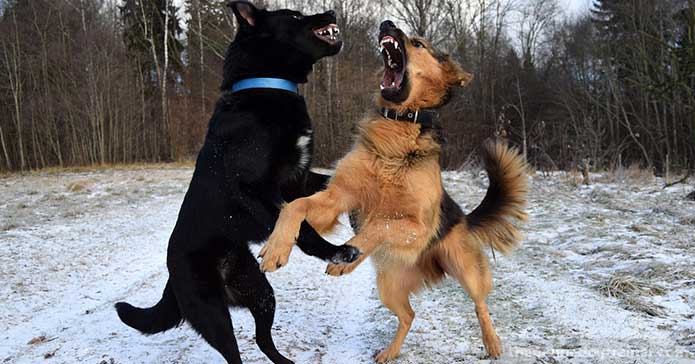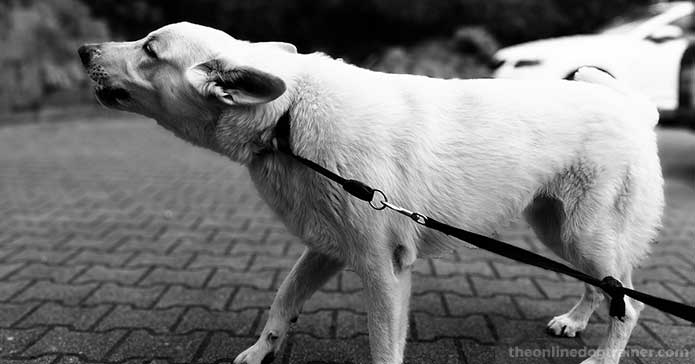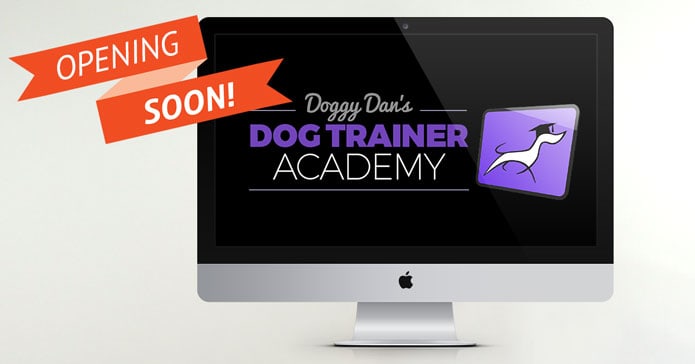
If you’re somebody who’s thought about becoming a dog trainer, but you’ve been put off because you’re concerned about the dangers of working with aggressive dogs, you’re not alone.
In fact, I encounter people every day who absolutely love dogs, but who also have fears about working with them–especially if they have aggressive tendencies. If you’re that person, this blog is definitely for you.
Hi I'm Doggy Dan, and inside my Dog Trainer Academy, I’m currently working with lots of people who are training to become dog trainers. And believe it or not, dog aggression is one of the key concerns this group worries about as they are pursuing a career in dog training.
Crazy, right? But it makes sense.
As a dog trainer, it’s likely that you’re going to encounter an aggressive dog from time to time, so it’s really important to be prepared and know how to handle the situation.
For that reason, dog aggression is an issue that we’ve spent a lot of time going over. And we’re constantly having conversations on how to keep yourself safe, the owner safe, the dog safe, and the public safe while working with aggressive dogs.
The last thing anybody wants is anything going wrong.
Here’s what I want you to understand though…
Chances are that your thoughts about the dangers of becoming a dog trainer are far worse than the reality of the risks you’ll actually encounter while working with dogs.
Let me just give you an example of what I’m talking about. If somebody told you to cross a very busy road, it may seem dangerous at first.
But, after a little thought, you realize it’s really not that dangerous as long as you take all the safety precautions like using a crosswalk, stopping in the meridian if cars are coming or waiting until traffic quiets down before you attempt to walk across.
However, if you’re told to just run across it blindfolded, that’s crazy dangerous.
It’s the same with dog training.

When you’re working with an aggressive dog, depending on the safety measures you take, it can be as dangerous as you want.
As you’re going to see in this blog post, it’s possible to make working with aggressive dogs incredibly safe. That’s why, even after working with several thousand dogs, I’ve only ever had a couple of tiny nips despite the fact that many of the dogs I was working with were very aggressive to humans.
So, here’s what you need to know so you can overcome your fear of aggressive dogs and become a dog trainer…
First of all, it’s important to put appropriate safety precautions in place for any dog you’re working with–even if he doesn’t have aggressive tendencies. Any dog, regardless of whether he is big, small, old, young, aggressive or even happy, can bite.
If you make mistakes and you put a dog in the wrong situations, it’s possible for any dog with teeth to nip.
So, you always want to take safety measures and play it safe. Usually this involves keeping the dog at a distance where they feel safe and can relax. So it may be that they are out in the garden or they are inside but on a leash away from you. Ensuring you set this up before you even enter the property will keep you safe.
The next thing is that you want to show people exactly how they should be working with their dog when a new situation arises.
In other words, when you turn up as a visitor, you’re a great example of how they should handle their dog and work with every visitor. You don’t want to be saying, ‘Oh, I’m special so I’m going to do this, but don’t ever let your visitors do this!’
You want to be showing them exactly what it is that they should do when people turn up. For example, this may mean that you instruct the dog owner to put the dog outside or on a short line, until the visitors come in and the dog settles down.
It’s all about playing it very, very safe. People appreciate this sort of sensible approach, the dog calms down, you can relax and everyone is happy. Remember you are not on a reality T.V show here trying to impress and entertain the viewers!
The third thing, is the concept that you really don’t want to take any chances because if a dog does bite, everybody loses. The dog loses because now he’s got a black mark against his name.
The dog owners are disappointed. They paid money and now the dog has bitten. And you’re all feeling bad or not happy because you’ve got a bite mark, and everybody loses.
How do you play it very safe? Once again, if it’s a very aggressive dog things are going to take time and perhaps the solution is to use a muzzle in certain unavoidable situations and until you start making progress with the dog. It’s ok to take it slow and use aids that ensure everyone stays safe.
If you have even the slightest bit of worry that a dog is going to bite or attack, protect yourself by setting the situation up safely before the consult even begins. It’s that simple, and everyone wins that way.
The three things we just talked about are important when you’re heading into a consult with people that truly have an aggressive dog.
But, want to know a little secret? A lot of times people classify their dog as aggressive, and it’s simply not true.
It’s very possible that you’ll get to your client’s home, sit down, have a cup of tea, chat with the client and then realize the dog they need your help with is a beautiful dog who is friendly with 99% of people.
The reason they need your help and have classified the dog as aggressive might be as silly as the dog growled at someone who was antagonizing the dog. In which case, the dog isn’t really aggressive and has every right to be a little peeved at being teased.
At this point, it’s all about educating the human about overstepping boundaries with the dog…and not so much about needing to ‘fix’ an aggressive dog.
Other times, though, a dog may be very aggressive and the owner may say, ‘Oh, he would never bite.’ It’s important that in this situation you go with your gut feeling and not just the owner’s word!
It’s up to you to set expectations and call the shots. If the dog is barking and jumping at the window trying to get at you, it’s totally acceptable to ask the owner to put a muzzle and a line on the dog.
You make the decisions, which in turn will keep you safe.
Dog-on-Dog and Dog-on-Human Aggression

As we move on, I think it’s important that we talk about the two main types of dog aggression.
The first type of aggression is dog-on-dog aggression. The other is dog-on-human aggression, where the dogs are aggressive to humans for some reason.
For the purposes of this post today, I want to focus mainly on dog-on-human aggression. This is generally the type of aggression which scares people away from wanting to work with dogs for a living.
The main type of aggression when it comes to dog on humans is what I call fear‑based aggression, where the dogs are actually scared and nervous.
I’m generalizing here because typically this type of aggression is caused by a mix between a dog being fearful and a dog being a little bit dominant. But mostly, this type of aggression is caused by a dog that is fearful.
Dogs that fall in this category are not looking for a fight. They’re not looking for trouble. However, if they’re put in a corner or if you approach them, they may become so scared that they will snap at you.
If you give dogs with this type of aggression a bit of space, they’re going to back off and back away.
That’s the good news.
Those dogs primarily are going to stay away from you, which means that when you get into their home. if they’re on a leash. you can put them in time out or you can move into the back garden…that sort of thing. They generally calm down once they see that you’re not a threat and then you can bring them back into the room to work with them.
Generally, that’s the way I like to work with these dogs.
The other types of dogs are what I call dominant dogs.
They’re usually very confident dogs who want to be the boss, who want be in charge and who want to control everything. They are certainly more pushy and are more likely to move towards you.
This might sound scary at first, but it’s actually good to know. This means you can prepare ahead of time to keep things safe by asking the owner to put the dog on a line so the dog doesn’t charge at you or try to dominate you.
How My Dog Training Methods Keep People Safe

So, how do my dog training methods actually help these dogs?
Well, first of all, I think it’s very important to understand that, as a dog trainer, I don’t ever say I’m going to come and magically train a dog. I don’t take a client’s dog away. I don’t say I’m going to wave a wand and sprinkle some magic dust into the food bowl.
Every technique I use is an understanding of how the dog’s mind works. I explain to the dog owners how a dog’s mind works. And then, when the owner understands what’s going on with their dog, they are then able to put some training in place that will transform their dog’s behavior.
It all begins with training, or should I say, educating the owner of the dog. Not so much being hands-on with the actual dog from the get-go.
At the end of the day, dogs have a hierarchy, which is very important to understand. Most times, an aggressive dog (whether they are dominant or fearful) is aggressive because they are making the decisions and they are trying to protect the property or protect their pack.
So, my training method begins by teaching dog owners to let their dog know, ‘Hey, I’m in charge. I’m going to protect the property. I’ll make the big decisions. You can switch off and relax.’
When you do this, the dog’s mind calms right down. It’s almost like you’re saying to them, ‘You can take the back seat. You don’t have to be this decision maker.’
That’s very powerful because, a lot of the time, aggression occurs because the dog’s mind flicks into this overexcited, over reactive state. Once they’re in that very excited and reactive state, it’s very hard to get through to them. This occurs because they believe they’ve got a job to do–they’ve got to protect the property and protect their owner.
So, if you can remove that role, they become far, far more relaxed, and working with the dog becomes far safer.
The foolproof way to keep yourself safe during a consult is to ring the client’s bell or make a phone call to ensure all the safety precautions are in place.
Once the owner puts your precautions in place, then you can turn up at the front door, and do another check before you come in.
It’s possible that you might work with an aggressive dog and never touch him once over the course of the training. And that’s perfectly ok.
Very often, I have said to a person, ‘I’m not going to end up touching this dog today, but I’ll give you the skills and the understanding of how you can transform the dog.’
I’ve rung people after a couple of weeks later and asked, ‘How’s it all going?’ and they said, ‘Absolutely, brilliant! The dog is nowhere near as reactive as he was.’
The amazing thing is most owners are very happy with this approach.
They don’t want high risk. They don’t want you seeing if you can kind of pat their dog on the head just so that you feel like you touched their dog.
They expect you to be the professional. So, when you provide logical, sensible, safe information, they’re very happy. They’re very grateful and you explain that not only are you dealing with the symptoms of the aggression but you’re also going to give them these exercises to help the dog’s mind control, which will deal with the cause of the problem.
That’s reversing this hierarchy, where the dog thinks he’s going to make all these decisions and protect you.
Hopefully, that has given you an idea of how much safer it is to work with these dogs than you probably thought. There are dogs where I’ve turned up and they are meant to be aggressive, and we’ve sat and played and had cuddles, and the person has been amazed.
There have also been consults where I know a dog is aggressive and make it clear that, for my own safety, I won’t be touching the dog. Nothing wrong with that.
The last thing I want to mention is that you are allowed to be choosy about your consults.
When you’re starting up, you may not feel good about taking on a very aggressive dog. That’s absolutely fine. There’s no rule that says you have to accept clients with aggressive dogs.
It’s okay to pass on a consult and say, ‘Hey, I don’t think I’m the right person for this job right now.’
There's nothing wrong with starting with easier dogs…dogs who are only a little bit aggressive maybe, or smaller, younger puppies.
At the end of the day, the idea that dog trainers are constantly working with aggressive dogs who are lunging and barking and trying to bite savagely isn’t the reality.
Perhaps one in every hundred dogs I come across is actually what I would call aggressive, and with those dogs, I play it incredibly safe. And when I play it safe, the owner can also relax, the dog relaxes and I relax.
When this is done, people can see how you can actually move forward using this slow, patient, logical and sensible approach.
So, don’t let aggressive dogs put you off from pursuing your passion to become a dog trainer.
If you’re still interested in becoming a dog trainer, I’d love to share more with you about my Dog Trainer Academy program.
If you're not ready to take the leap to become a dog trainer yet, I advise that you take a different route and check out my program, The Dog Calming Code.
This program will give you all the training tools you need to learn the best way to train dogs to remain calm and listen to you when it matters most!
See how I've trained over 88,000 dogs here!
Have a great day and thanks for reading this post.
Cheers,

~Doggy Dan








2 Responses
Doggy Dan has changed my thinking and my life! I look at relationships with dogs and with people differently! This may sound strange, but I am progressing through his courses with my now 7 month old schnoodle and learning every day how to make her comfortable and happy by being the leader. It takes all of the pressure off of her to take care of me and gives her confidence. When I was growing up my parents didn’t know how to “be the pack leader” and I consequently felt the constant stress of taking care of everyone and every situation. I look at Molly and I never want her to feel like that. This has and continues to be a great experience for both of us. She can decide not to eat her food and it is not my fault or here. She simply has chosen not to eat until her next feeding. If she is overly excited I have tools to help her calm down. It also give me a clue about what she is picking up in the household! Thank you Doggy Dan!
Hi Susan….wow thanks for the fantastic feedback! I’m really glad you are enjoying my courses and have found it so helpful for your relationship with Molly. I love your comparison to your childhood and you’re absolutely right, no-one likes to feel the stress & anxiety of feeling out of their depths with the responsibilities they have (or had to) take on….our dogs are no different here! I’m so happy you feel you now have the skills and strategies that will allow Molly to live a happy & stress-free life…that’s what owning a dog should be all about. Keep up the great work…Doggy Dan